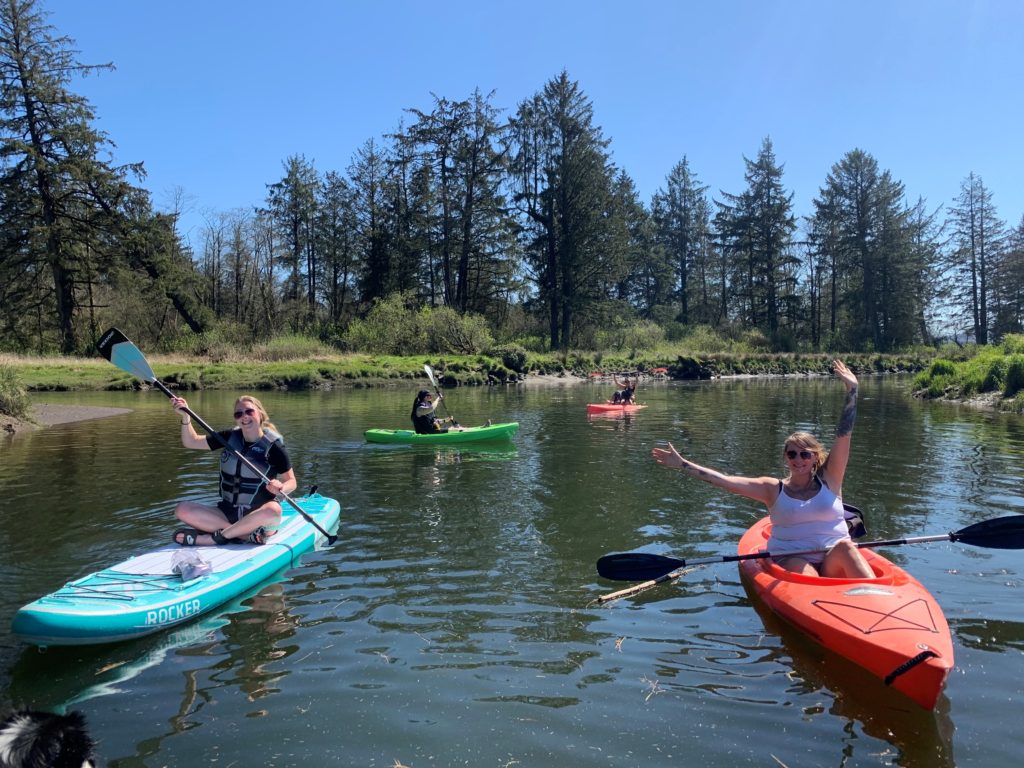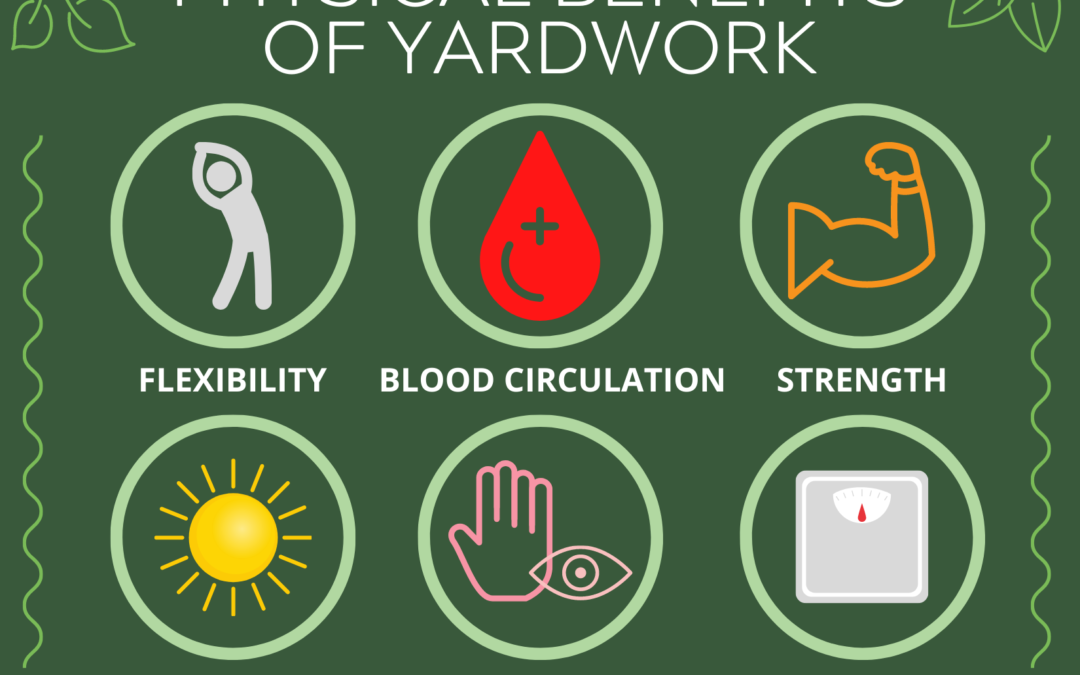
by Guest | Jul 14, 2021 | Move Well
We all know that physical activity is an important part of a healthy lifestyle, but who has time for workouts during the summer when there is so much work to do in the yard and garden? Well, you will be happy to hear that many of those tasks around the yard qualify as bona fide exercise. According to the Centers for Disease Control and Prevention (CDC), general gardening counts as moderate exercise, and activities like hoeing or digging count as vigorous exercise. If you are a gardener, you already know gardening is a good workout!
Not only do yardwork and gardening burn calories, these activities often involve stretching, bending, pulling, lifting, and digging, which can tone muscles, increase strength and flexibility, and build endurance. It can also help lower your blood pressure. The National Institutes of Health says common chores like gardening or raking leaves for 30+ minutes several times a week as activities that can help reduce your risk of heart disease.
Yardwork and gardening come with other benefits, too. Spending time outside in nature reduces stress, and the repetitive nature of yardwork can help focus the mind in a way similar to meditation. Exposure to sunlight is good for your bones as it boosts Vitamin D, which helps your body absorb calcium. (Don’t forget to wear sunscreen, though, if you are going to spend more than a few minutes in the sunshine.) Time spent outdoors and the physical exertion of gardening can also help you sleep better.
When working in the yard, it is a good idea to vary your activities so you use a variety of muscles but not overdo any particular set of muscles. For instance: prune for a while, weed-eat for a while, rake for a while, mow for a while, and so on. Listen to your body – it will tell you when it’s time to take a break and switch to a new activity. It can also be helpful to switch sides every few minutes – dig, rake, or weed with your right arm, then your left, to work all the muscles. And of course, we probably don’t need to tell you that manual tools offer a better workout than electric or gas-powered. Using manual clippers, shears, and push mowers works more muscles and burns more calories than electric or gas-powered tools.
The CDC recommends (and so does Tillamook County Wellness) that you make sure to stay safe when gardening or working in the yard: drink plenty of water and take shade breaks as needed; make sure to apply sunscreen; wear gloves, goggles, long pants, and closed-toe shoes, especially when using sharp tools; make sure you have a current tetanus vaccination; and pay attention to your body – it’s easy to overdo when you are digging or carrying heavy loads.
We hope you are inspired to count your gardening as a good workout – good for your body, good for your mood, and good for your yard! Not to mention the sense of accomplishment you feel when you look at that freshly-mowed lawn, or that weed-free flower bed, or a section of your yard finally freed from the ever-encroaching blackberry brambles. But don’t worry – your exercise routine can continue across the seasons because the grass will keep growing, as will the weeds and the blackberries; there is always something to do in the yard or garden!
AUTHOR: TCW Health Promotions Team
For more local health and wellness information, follow Tillamook County Wellness on Facebook, Instagram and Twitter.

by Guest | Jul 7, 2021 | Move Well
Tillamook County offers an abundance of outdoor recreational opportunities, particularly in the water. Stand up paddleboarding, kayaking, and other paddle sports are a great way to enjoy the local scenery while getting some fresh air and a good workout. From complete beginners to those with extensive experience, Tillamook County has waterways that will appeal to every skill level and the resources to help make it a fun and safe experience.
Stand up paddleboarding (or SUP) has recently gained popularity, and for good reason. Besides being a relatively easy activity to pick up, it offers a fun and effective whole-body workout. It provides good aerobic exercise, and you will build core, arm, and leg strength while balancing and paddling. SUP is also low impact, making it ideal for people of all fitness levels, and you get to enjoy fresh air and beautiful scenery while you do it. An added benefit – you can grab a refresher by jumping into the water whenever you want!
However, before you run out to buy a paddleboard and hop in the water, it is important to have the proper equipment and training. You’ll find a brief overview below, but be sure to check out the Oregon State Marine Board’s Boater Info for more extensive safety information: https://www.oregon.gov/osmb/boater-info/pages/non-motorized-boating-and-paddling.aspx.
Being prepared starts with having the right equipment. The Oregon State Marine Board requires that all boats (including SUPs) have an appropriately sized life jacket for each person on board, a sound-producing device (like a whistle), and a Waterway Access Permit (which can be purchased through the Marine Board’s Boat Oregon Store: https://apps3.oregon.gov/). Also be sure to use an appropriate leash or tether to ensure you do not get separated from your SUP and always wear your life jacket. Be sure to dress in non-cotton clothes that are appropriate for the weather and water temperature.
Also make sure you are prepared with the correct training and information before you get out on the water. Do some research on your route ahead of time so you know what to expect in terms of water conditions and weather. Create a float plan and give it to a friend or family member before you leave, so they know when to expect you to return. Always go out with a group, and be aware of other boaters around you. Consider taking a paddle sports safety course before your first time out; the Oregon State Marine Board has a free introductory course, as well as plenty of other resources and safety tips on their website.
Not sure where to start with your aquatic adventures? Tillamook County offers some great resources to help you get started. If you’re just looking to rent a paddleboard and get yourself out there, Wheeler Marina and Oceanside Surf and SUP both offer affordable rental options. If you need a good spot to float, the new Tillamook County Trails and Recreation Map includes information about water trails, boat launches, and beach and water access that you can use to plan your trip. The Tillamook County Water Trail Committee has established the Tillamook County Water Trail, approximately 200 miles of interconnected waterways. Free printable guidebooks for this trail, including information about public access points and typical water conditions, can be found on the TEP website, or you can obtain a printed waterproof guidebook at the TEP office or by mail for a suggested donation of $10.
If you are interested in lessons or guided SUP tours, SUP Manzanita offers lessons taught by local expert Janice Gaines-Ehlen. These lessons can accommodate all skill and fitness levels. Janice, an outdoor enthusiast, has been surfing since the age of 8 and has a passion for nature, adventure, fitness, and health. You can find more information about her lessons and guided adventures here: https://www.supmanzanita.com/. If kayaking is more your speed, you can find information about local kayaking spots and services here: https://tillamookcoast.com/what-to-do/kayaking/.
However you choose to do it, Tillamook County is a great place to enjoy the water. Take these tips to get out there, enjoy the warm summer weather, have some fun, and find a new adventure. For more ideas, and inspiration, visit our website: https://tillamookcountywellness.org/move-well/
AUTHOR: Amy McVeety, AmeriCorps VISTA at Tillamook County Community Health Center
Photo Credit: Tillamook County Water Trails
For more local health and wellness information, follow Tillamook County Wellness on Facebook, Instagram and Twitter.
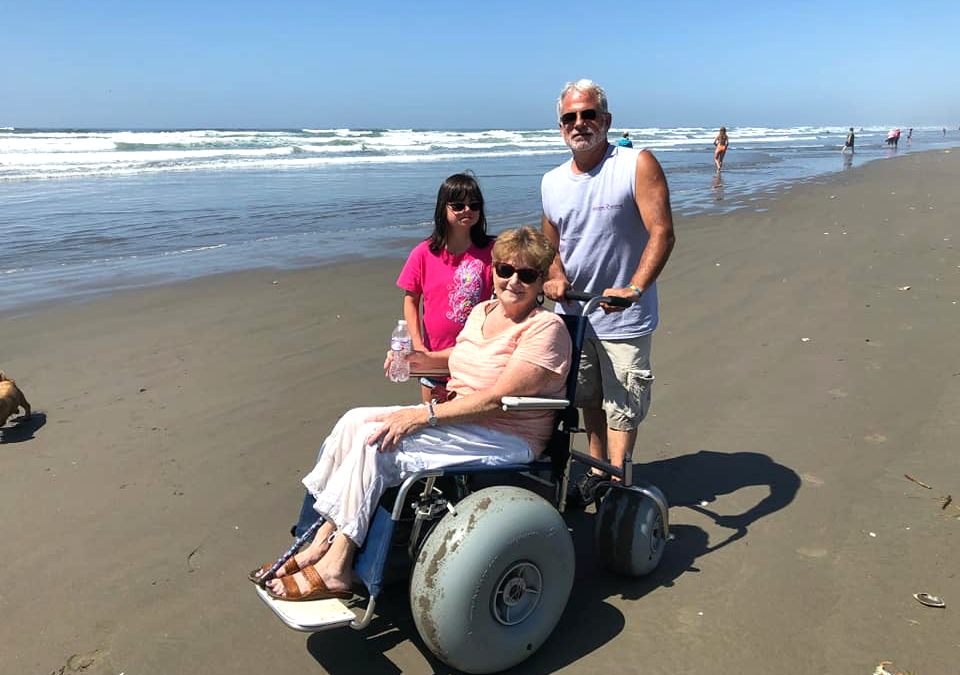
by Guest | Jun 30, 2021 | Move Well
Photo Credit: Visit Tillamook Coast
Tillamook County offers beautiful, sandy beaches for all to enjoy. The Pacific Ocean, rocky bluffs and sandy dunes provide stunning views. But for wheelchair users or anyone with a mobility aid (cane, crutches, walkers and scooters), the shifting sands can be treacherous and often impossible to navigate. Fortunately, you can still enjoy a day at the beach with a specially designed beach wheelchair, available for loan at three popular towns on the Tillamook Coast: Manzanita, Pacific City and Rockaway Beach.
Unlike standard or motorized wheelchairs, beach wheelchairs feature oversized wheels that easily glide over sand and won’t get stuck. Most of these wheelchairs do require someone who can push the chair for the occupant. For the wheelchairs user’s comfort and safety, consider bringing a cushion from home. Also, some wheelchair users may find transferring from their personal chair to a low-slung beach chair difficult and should plan accordingly.
The beach wheelchairs are free to use, but we strongly recommend reserving a beach wheelchair in advance. In Tillamook County, you can borrow a beach wheelchair at the following locations:
More wheelchairs and mobility equipment will be added as they get funded, we are expecting another wheelchair in Garibaldi soon to help people navigate docks and marinas, and a kayak launcher in both Garibaldi and Wheeler. That will allow more people enjoy our stunning beaches and outdoor venues. Visit Tillamook Coast offers up-to-date resources at https://tillamookcoast.com/mobility/.
AUTHOR: Patti Atkins, APR, Communications Consultant for Tillamook County Community Health Center
For more local health and wellness information, follow Tillamook County Wellness on Facebook, Instagram and Twitter.

by Guest | Jun 23, 2021 | Move Well
As the saying goes, if you love your job, you’ll never work a day in your life. Sarah Patterson did not set out to have the career she has fallen in love with but she is grateful for it every day. Her journey began when she enrolled as a student at TBCC and learned she had to take PE classes to meet the degree requirements. Through a local partnership, she was able to take those classes at the Tillamook YMCA. As Sarah recalls, “I signed up for the Step & Sculpt class. It was really hard. I weighed 250 pounds and I couldn’t even get through the first 10 minutes of class without having to stop and take a break.” Committed to her education goals, Sarah stuck it out and attended the class three days a week for the entire term despite the challenge.
While her initial motivation was to complete her degree requirements, the changes she began to notice in herself added more motivation to keep going. “Within a month I saw weight loss, body changes, I felt stronger. It felt good to move.” With newfound confidence and skills, Sarah joined other classes, trying everything from Boot Camp to Zumba.
After a year of taking fitness classes, one of the instructors approached Sarah about subbing, noting how quickly Sarah picked up the movement patterns. “I was nervous but I agreed to do it,” she says and, after subbing one class, Sarah had that ‘aha’ moment, thinking, “This is what I want to do.” After subbing for the Zumba class over the summer, Sarah took the training to become a certified Zumba instructor. Her enthusiasm and ability to learn quickly caught the attention of the Group Fitness Coordinator who asked her to pick up additional certifications.
Every step of the way, Sarah felt like she was venturing outside of her comfort zone but she kept an open mind and pursued each new training relying on the trust others had placed in her. “It was very exciting. Before I knew it, I was teaching 10 classes a week.” She continues, “Every day I drive to work and can’t believe this is my life. I just feel so shocked and grateful that this is my job.”
At first, fitness was a side gig for Sarah as she continued her work as a longtime waitress. She began looking for ways to get more hours at the Y to make it a full-time career. It was a risk, leaving steady work in the restaurant industry but she felt she had to make that leap and began working in childcare at the Y. Having lost 75 pounds by this point, Sarah found that she had the energy and passion to get the kids moving and having fun. “I love my job working with kids because it relates so much to my role as a fitness instructor,” she says. During the covid pandemic, while the Y was offering a hybrid learning environment, Sarah was able to use her skills to guide student PE sessions, noting that it was great to see kids learning about how physical activity changes their bodies.
Passionate and enthusiastic, Sarah plans to keep learning and growing into her new career. She is looking into becoming a personal trainer and bringing Zumba back to the college as a PE credit class. She loves teaching and hopes to have the same impact others had on her. “I hear from students all the time about how these classes are changing their lives,” she says. And, for those who are nervous about trying something new, Sarah has important advice based on her own journey, “Not everyone starts out as someone who has done sports their whole life or is super fit.” Even though Sarah has lost 75 pounds, she is quick to point out that this is more about how we feel than how we look. This transformation has translated to other areas of her life. Overall, Sarah says she is a much happier person, a better partner and mom to her son. When asked what advice she would give to others, Sarah encourages others to not be afraid to try something new. “Listen to that inner voice, be willing to step out of your comfort zone and see where it takes you.”
AUTHOR: Michelle Jenck, Adventist Health Tillamook Director of Community Well-Being
For more local health and wellness information, follow Tillamook County Wellness on Facebook, Instagram and Twitter.
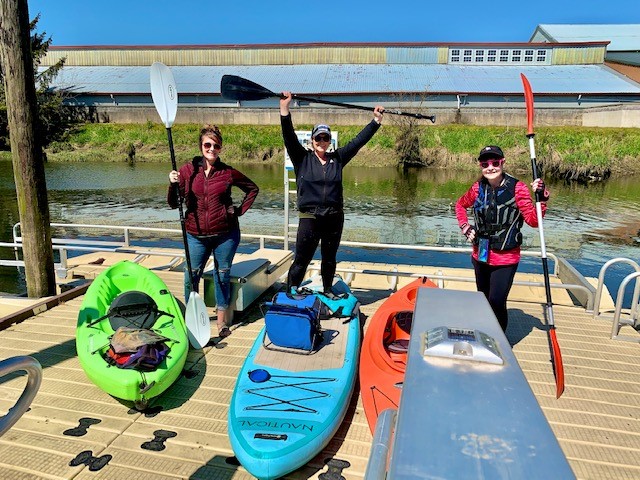
by Guest | Jun 16, 2021 | Move Well
On a beautiful Friday morning, I got a call at 9 am from Cami Aufdermauer whom I had yet to meet. I had been connected with her to do a brief interview about her new Facebook page, Tillamook County Adventures, where she has been sharing stories and strategies for paddle boarding and kayaking in Tillamook County. Little did I know, I would be doing the interview while out on the water with her later that afternoon.
As Cami pointed out while we paddled through the Hoquarten Slough, this freedom to explore without needing too much prior planning is something she has taken advantage of during the pandemic. As the Executive Director of the Tillamook County Habitat for Humanity, this past year of remote meetings and virtual work has opened up new flexibility in her work-life balance. With the stay-at-home orders, Cami took the opportunity to explore the area by water: “You can grow up in a place, and think you know everything about your hometown, but it always shocks me that I can live here for 36 years and say ‘This is the first time I’ve seen this and it’s two miles from my house.’ It just reminds me of how grateful I am.”
So how did she get started? Cami started joining Facebook groups for people who were new to paddle boarding and kayaking, and she slowly started acquiring the gear needed to hit the water. She points out that there are a range of “luxuries” that can be added to your trips, such as waterproof bags or cases for phones, cup holder attachments for drinks, or anchors for holding in place while taking a moment to read a few pages of a book while on your kayak. But the valuable piece is the life jacket – she points out that investing in one that is comfortable and fits well means you are most likely to wear it while out on the water.
Cami recommended the Hoquarten Slough in Tillamook as a great place for new paddlers: It is slow-moving with an easy-entrance dock in the center of Tillamook at the Sue H. Elmore Park. As someone who has spent very little time on a paddleboard, I can vouch for the ease in getting comfortable on the water at the slough (and even for standing up on the paddleboard!) It was a beautiful and relaxing afternoon paddling through the winding slough, and it was wonderful to meet a few new people who were just as excited about exploring Tillamook County.
And this connection is what really sparked the Tillamook County Adventures Facebook page – as Cami pointed out, “collectively, we have been to a lot of places” and although people might be inspired by photos or videos, they may not know how to really get started. The goal of the page is to share their stories and offer opportunities for others to tag along on adventures. As Cami observed, “People are missing out on connection: we can be intentional about getting outside and getting healthy, but that human interaction is more critical than it has ever been.”
Tillamook County has so much to offer: the bay, the oceans, the hiking, the bike paths, the rivers, and more. So if you’re interested in connecting with others who are looking to explore the beautiful areas around us, check out the Tillamook County Adventures Facebook page. Many people live in areas where they have to drive hours to overcrowded spots in order to paddle board or kayak, but here it can be as easy as getting a call at 9 am and floating on the water that afternoon. As we paddled back to the dock, Cami offered a final thought: “This is a way to be free and enjoy living in the moment and that’s something I want to practice more of: being present, living in the moment, and enjoying the journey.”
AUTHOR: Ariel Slifka, AmeriCorps VISTA at Tillamook County Community Health Center
For more local health and wellness information, follow Tillamook County Wellness on Facebook, Instagram and Twitter.
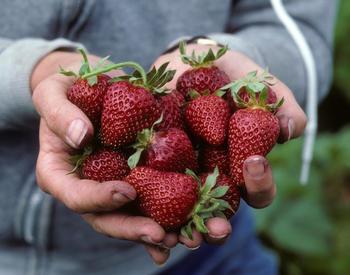
by Guest | Jun 10, 2021 | Move Well
Gardening has become one of the most popular activities during the pandemic as people spent more time at home, embraced “grow your own” and enjoyed the win-win-win: fresh air and activity, fresh veggies, berries, fruits and beautiful landscape.
As a Master Gardener, friends and family make regular inquiries (texts with “what’s this plant/flower? Bug? What’s wrong with my plant?” etc. etc.) It’s one of the many joys of being a Master Gardener, helping folks have a positive experience. From year to year, a common question, “Is this a ‘normal’ year?” We all know that normal left the scene some time ago … especially this year, my answer is “no, this is not a normal growing year.” I was watering in APRIL! What?!? And, our garden was “in” by early May. During a “normal” year, we’d be lucky to have the ground dry out enough to plant by Memorial Day. That’s right – planting by Memorial Day, early June is the usual …
The best tips I can provide this year would focus on WATERING, and make plans to make your landscape and gardens “water-friendly.” Consider xeriscaping (low/no water) and native plants are also the best option, but even native plants are going to need supplemental water this year. If you have “new” (planted within the last three to five years) landscape trees, bushes and plants, be sure to regularly water them. New residents (and even long time residents) don’t realize that it can take several years for plants and trees to become established, so during the dry season – yes, we have a dry season on the Oregon Coast, supplemental water is a must.
This is an excellent resource with timely advice on garden chores, fertilizing, pest control, and more from OSU Extension. When in doubt, contact the Tillamook OSU Extension Office for information from local Master Gardeners, https://extension.oregonstate.edu/tillamook
OSU Extension – June Garden Calendar
Oregon State University Extension Service encourages sustainable gardening practices.
Practice preventive pest management rather than reactive pest control. Identify and monitor problems before acting, and opt for the least toxic approach. Conserve biological control agents such as predators and the parasitoids that feed on insect pests.
Maintenance and cleanup
- Prune lilacs, forsythia, rhododendrons and azaleas after bloom.
- Fertilize vegetable garden one month after plants emerge by applying a side dressing alongside rows.
- Harvest thinnings from new plantings of lettuce, onion and chard.
- Pick ripe strawberries regularly to avoid fruit-rotting diseases.
- Use organic mulches to conserve soil moisture in ornamental beds. An inch or two of sawdust, bark dust or composted leaves will minimize loss of water through evaporation.
- After normal fruit drop of apples, pears and peaches in June, consider thinning the remainder to produce a crop of larger fruit.
- Make sure raised beds receive enough water for plants to avoid drought stress.
- Mid-June: If green lawns are being maintained through the summer, apply 1 pound nitrogen per 1,000 square feet to lawns.
- If you want a green lawn, water frequently during periods of heat and drought stress. Irrigate 0.25 inches four to six times per week from June through August. Measure your water use by placing an empty tuna can where your irrigation water lands.
Planting and propagation
- Plant dahlias and gladioli.
Pest monitoring and management
Use chemical controls only when necessary and only after thoroughly reading the pesticide label. First consider cultural, then physical and biological controls. Choose the least-toxic options, and use them judiciously. Some examples include insecticidal soaps, horticultural oils, botanical insecticides, and organic and synthetic pesticides.
- First week: Spray cherry trees for cherry fruit fly, as necessary, if fruit is ripening.
- First week: Spray for codling moth in apple and pear trees, as necessary. Continue use of pheromone traps for insect pest detection.
- Learn to identify beneficial insects and plant some insectary plants, — such as alyssum, Phacelia, coriander, candytuft, sunflower, yarrow and dill — to attract them to your garden. Check with local nurseries for best selections. For more information, see Encouraging Beneficial Insects in Your Garden.
- Blossoms on squash and cucumbers begin to drop; this is nothing to worry about. Cherries may also drop fruit; this is not a major concern.
- Monitor azaleas, primroses and other broadleaf ornamentals for adult root weevils. Look for fresh evidence of feeding (notching at leaf edges). Try sticky trap products on plant trunks to trap adult weevils. Protect against damaging the bark by applying the sticky material on a 4-inch wide band of poly sheeting or burlap wrapped around the trunk. Mark plants now and manage root weevils with beneficial nematodes when soil temperatures are above 55 degrees Fahrenheit. If root weevils are a consistent problem, consider removing plants and choosing resistant varieties.
- Control garden weeds by pulling, hoeing or mulching.
- Control aphids on vegetables as needed by hosing off with water or by using insecticidal soap or a registered insecticide.
- Watch for 12-spotted beetles on beans, cucumbers and squash and cabbage worms or flea beetles in cole crops (cabbage, broccoli, Brussels sprouts). Remove the pests by hand or treat with registered pesticides.
- Birch trees dripping a sticky fluid from their leaves means that aphids are present. Control as needed.
- Use yellow sticky traps to monitor for cherry fruit fly. About 1 week after the first fly is caught, spray cherries at appropriate intervals.
- Last week: Second spray for codling moth in apple and pear trees, as necessary.
- Continue monitoring blueberry, strawberry, cherry and other plants that produce soft fruits and berries for spotted wing drosophila. If these pests are present, use an integrated and least toxic approach to manage the pests. To learn how to monitor and manage spotted wing drosophila.
Trade-name products and services are mentioned as illustrations only. This does not mean that the Oregon State University Extension Service endorses these products and services or intends to discriminate against products and services not mentioned.
Monthly Garden Calendars
AUTHOR: Laura Swanson, Master Gardener since 2004
For more local health and wellness information, follow Tillamook County Wellness on Facebook, Instagram and Twitter.






